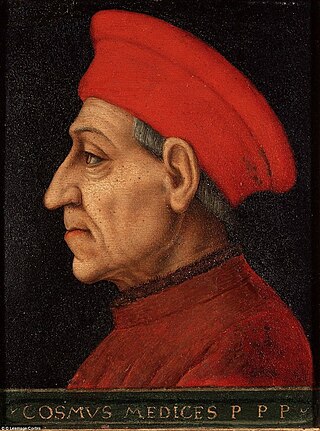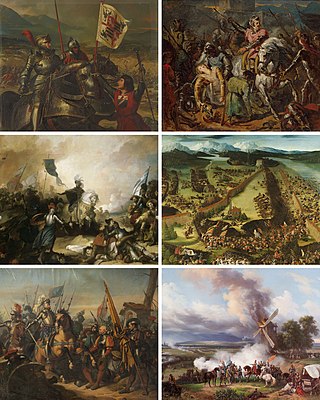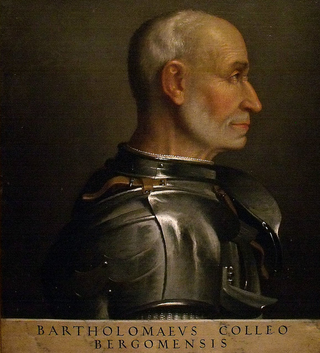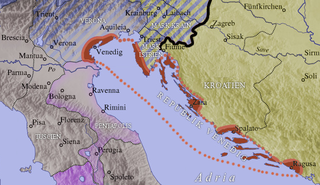
Francesco I Sforza was an Italian condottiero who founded the Sforza dynasty in the duchy of Milan, ruling as its (fourth) duke from 1450 until his death.

Ludovico III Gonzaga of Mantua, known as the Turk, also spelled Lodovico was the ruler of the Italian city of Mantua from 1444 to his death in 1478.

Cosimo di Giovanni de' Medici was an Italian banker and politician who established the Medici family as effective rulers of Florence during much of the Italian Renaissance. His power derived from his wealth as a banker and intermarriage with other rich and powerful families. He was a patron of arts, learning, and architecture. He spent over 600,000 gold florins on art and culture, including Donatello's David, the first freestanding nude male sculpture since antiquity.

The Italian Wars were a series of conflicts fought between 1494 and 1559, mostly in the Italian Peninsula, but later expanding into Flanders, the Rhineland and Mediterranean Sea. The primary belligerents were the Valois kings of France, and their Habsburg opponents in the Holy Roman Empire and Spain. At different points, various Italian states participated in the war, some on both sides, with limited involvement from England and the Ottoman Empire.

The Republic of Florence, known officially as the Florentine Republic, was a medieval and early modern state that was centered on the Italian city of Florence in Tuscany, Italy. The republic originated in 1115, when the Florentine people rebelled against the Margraviate of Tuscany upon the death of Matilda of Tuscany, who controlled vast territories that included Florence. The Florentines formed a commune in her successors' place. The republic was ruled by a council known as the Signoria of Florence. The signoria was chosen by the gonfaloniere, who was elected every two months by Florentine guild members.

The Duchy of Milan was a state in Northern Italy, created in 1395 by Gian Galeazzo Visconti, then the lord of Milan, and a member of the important Visconti family, which had been ruling the city since 1277.

The Golden Ambrosian Republic was a short-lived republic founded in Milan by members of the University of Pavia with popular support, during the first phase of the Milanese War of Succession. With the aid of Francesco Sforza they held out against the forces of the Republic of Venice, but after a betrayal Sforza defected and captured Milan to become Duke himself, abolishing the Republic.

The First Italian War, or Charles VIII's Italian War, was the opening phase of the Italian Wars. The war pitted Charles VIII of France, who had initial Milanese aid, against the Holy Roman Empire, Spain and an alliance of Italian powers led by Pope Alexander VI, known as the League of Venice.

The Italian Wars of 1499–1504 are divided into two connected, but distinct phases: the Second Italian War (1499–1501), sometimes known as Louis XII's Italian War, and the Third Italian War (1502–1504) or War over Naples. The first phase was fought for control of the Duchy of Milan by an alliance of Louis XII of France and the Republic of Venice against Ludovico Sforza, the second between Louis and Ferdinand II of Aragon for possession of the Kingdom of Naples.

Bartolomeo Colleoni was an Italian condottiero, who became captain-general of the Republic of Venice. Colleoni "gained reputation as the foremost tactician and disciplinarian of the 15th century". He is also credited with having refurbished the Roman baths at Trescore Balneario.

Bianca Maria Visconti also known as Bianca Maria Sforza or Blanca Maria was Duchess of Milan from 1450 to 1468 by marriage to Francesco I Sforza. She was regent of Marche during the absence of her spouse in 1448. She served as Regent of the Duchy of Milan during the illness of her spouse in 1462, as well as in 1466, between the death of her spouse and until her son, the new Duke, who was absent, was able to return to Milan to assume power.

The Wars in Lombardy were a series of conflicts between the Republic of Venice and the Duchy of Milan and their respective allies, fought in four campaigns in a struggle for hegemony in Northern Italy that ravaged the economy of Lombardy. They lasted from 1423 until the signing of the Treaty of Lodi in 1454. During their course, the political structure of Italy was transformed: out of a competitive congeries of communes and city-states emerged the five major Italian territorial powers that would make up the map of Italy for the remainder of the 15th century and the beginning of the Italian Wars at the turn of the 16th century. They were Venice, Milan, Florence, the Papal States and Naples. Important cultural centers of Tuscany and Northern Italy—Siena, Pisa, Urbino, Mantua, Ferrara—became politically marginalized.

The Republic of Venice was a sovereign state and maritime republic in Northeast Italy, which existed for a millennium between the 8th century and 1797.
Carlo Gonzaga, Lord of Sabbioneta, was an Italian nobleman of the Mantuan House of Gonzaga who rose to the position of Captain of the People in the Ambrosian Republic of Milan, and eventually ruled practically as an autocrat. He was the younger son of Gianfrancesco Gonzaga and Paola Malatesta, as well as a friend of the humanist writer Francesco Filelfo. His brother was Ludovico III Gonzaga, Marquis of Mantua, and became a rival of his for Mantua and in the field of battle.

The Italic League or Most Holy League was an international agreement concluded in Venice on 30 August 1454, between the Papal States, the Republic of Venice, the Duchy of Milan, the Republic of Florence, and the Kingdom of Naples, following the Treaty of Lodi a few months previously. The next forty years were marked by peace and economic expansion based on a balance of power within Italy. The decline of the League brought about the Italian Wars.
The Battle of Ghedi was a battle during the long conflict between the Republic of Venice and the Duchy of Milan which lasted between the years 1425 and 1454.
The Milanese War of Succession was a war of succession over the Duchy of Milan from the death of duke Filippo Maria Visconti on 13 August 1447 to the Treaty of Lodi on 9 April 1454.
The third siege of Pontevico was fought between 16 and 19 October 1453 at Pontevico (Lombardy) between the armies of the Duchy of Milan and that of Republic of Venice, an episode of the Wars in Lombardy.














